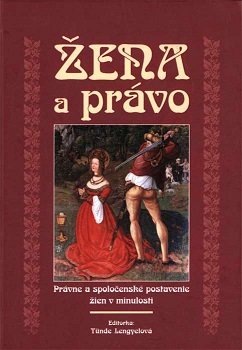Žena v systéme Žilinského magdeburského práva
Woman and the Magdeburg law system from the town of Žilina
Author(s): Michal Bada
Subject(s): Gender Studies, History of Law, Middle Ages
Published by: SAV - Slovenská akadémia vied - Historický ústav SAV
Keywords: Slovakia; Žilina; women; Magdeburg law; middle ages;
Summary/Abstract: The author uses an example of the Magdeburg law system from Žilina (ŽMP) for the analysis of the position of women in a medieval law system. Legal options and boundaries for women determined 'ways of their survival' and were reflected in 'a legal atmosphere' of the past. The medieval town offered two different 'legal statuses' for both sexes. The Magdeburg law (Sachsen spiegel) dates back to the second half of the 12th century. It spread rapidly throughout Europe during the first half of the 13th century. Žilina used the law of the town of Tesin (Flemish law), but was ordered by the king in 1369 to change to the Magdeburg law, as used in the town of Krupina. Under the influence of slovakization of Žilina the text of the Magdeburg law was translated into slovakized Czech (i.e. Czech with numerous Slovak elements). The articles that concern women, apart from those that touch upon them only marginally, can be divided into two basic groups - dealing with criminal punitive and hereditary issues. Women in ŽMP did not have full rights. They formed a special group of the urban environment and their status was formed by protective as well as some restrictive regulations. For example they could not carry an arm, during the court trial they had to have more witnesses than men and they could personally witness in court only in cases of rape and debts. On the other hand, they were protected during the pregnancy even if condemned and while taking an oath they were allowed to sit if they were not physically fit. There are detailed instructions concerning murders and lethal injuries or physical damages committed by women in ŽMP. In addition, the law deals with legal position of illegitimate children. The most numerous are articles about the family law, marital property issues and hereditary process. A woman gained by marriage the same legal position as her husband. Though the marital property was considered joint, it was the husband who was in charge of it. An interesting feature of marital property rights was the phenomenon of paternal property. It was called vater halbe (paternis in Latin) and there is a maternal equivalent for that in ŽMP - maternis. There were precise rules as to what property belonged to the wife and what to the husband and which part of it should go to her and his relatives after their death. In court hereditary cases there was an institution of a special speaker „vor munde", who had a joint role of women's (but also of children and of men over 60) defender and personal legal representative. This role was usually fulfilled by her husband, father or other male relative over 21 years of age. Records in town protocols mostly concern wealthy and prominent families and testify that the complicated ŽMP hereditary system was really used in practice. From the end of the 15th century husband and wife could use testamentary freedom and form their last wills in front of town magistrate. This right can be seen as emancipation of married couples and their liberalization from the family ties.
Book: Žena a právo. Právne a spoločenské postavenie žien v minulosti
- Page Range: 24-45
- Page Count: 22
- Publication Year: 2004
- Language: Slovak
- Content File-PDF

